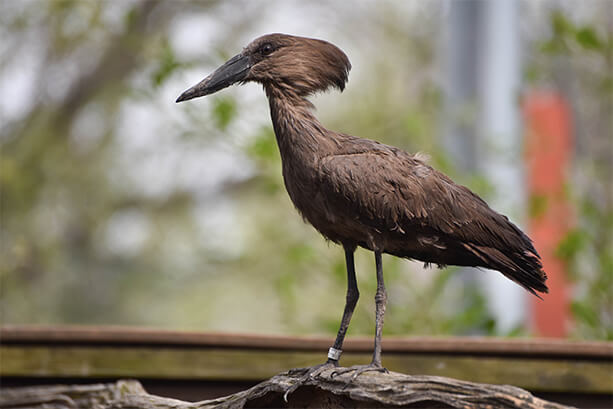The Giraffe House is currently closed for Kipi and her calf.
If you visit our African Aviary in the springtime you may notice what looks like an enormous tumbleweed suspended in the trees or up on the trellis. This is actually a hamerkop nest (Scopus umbretta). Renowned as the biggest construction by any African bird species it’s just one, albeit large, reason these birds are becoming more popular at zoos across the U.S.
Another reason is the work of people like Jen Kottyan, Maryland Zoo’s curator of birds, coordinator of the Association of Zoos and Aquariums (AZA) Hamerkop Species Survival Plan (SSP), and keeper of the hamerkop studbook – a registry of each bird and its genetics used to determine breeding recommendations.
We sat down with Jen to talk about these birds and how changes to the breeding program are more in sync with the birds’ natural cycles.
Q: What drew you to hamerkops in particular?
Jen: Hamerkops are super charismatic. They’re cool birds, and that’s not just because they make the biggest nests. They’re vocal, active, and personable.
Q: Speaking of the nests, they require a lot of building material. Do you supplement what they find naturally in the aviary?
Jen: We provide some things but they’re good at using grasses and sticks from the yard. They’ll also use non-organic materials – random stuff that visitors may drop in the aviary. If you search social media, there are a lot of posts documenting odd things the bids use as construction material. A finished nest may contain as many as 8,000 items and weigh over 50 pounds.
Q: What does your role as the hamerkop studbook keeper entail?
Jen: Studbook keepers work with specialists at the AZA’s Population Management Center who document the genetics of each species. That information is used to make breeding recommendations. We compare every bird listed at an accredited zoo and mate them with appropriate genetic matches. So, a big part of the job is communicating across all the different zoos holding hamerkops.
Q: How is the species doing in North America?
Jen: The birds have been in U.S. facilities since 1958. There had been a decline in reproduction rates but the numbers have picked back up.


Q: What caused the numbers to drop?
Jen: Breeding transfer plans were happening every two-to-three years. If a facility had a successful clutch of eggs that yielded two-to-four offspring they would have to hold those birds until the next round of breeding recommendations. Once a bird is transferred for breeding, they then go through quarantine. So, a bird could be four or five years old before getting paired up and that’s pretty late for this species.
Now, we’re doing breeding and transfer plans every year and, with the current software, I can make interim recommendations. So as birds are laying eggs and the chicks are fledgling, I can say this bird should go here and put that one there. Instead of three or five years, we can move a bird when it’s five, six months old, which helps them get paired up and bonded right before they’re a year old.
Our new female hatched at another zoo in February of 2023. When we saw that she’s genetically compatible with our male I made the recommendation to bring her here. So she’s not even a year old, and she’s been transferred, gone through quarantine, howdied to the male, and already paired up.
Q: How is she getting along with the male?
Jen: They’re doing great. When she got out of quarantine she went directly to the winter holding area (because of the cold air temperatures) where we slowly introduced her with the rest of the group. We saw encouraging behaviors through the mesh. Once we opened the door between them he’s been vocalizing and they’ve been hanging out together. So I think it’ll go well once they move outside in the spring.
Q: When do the birds go back out to the aviary and what hamerkop mating behavior can people look for?
Jen: We try to have them back out by April first but it’s temperature dependent. Once it’s consistently over 40 degrees at night, that’s when they’ll move back.
You’ll see our male start to collect things and deposit them at his chosen nest site. And then he’ll actually land on the female’s back and flap his wings and vocalize a lot. Those are all courtship behaviors.
Q: What else should our guests look for when the birds return to the aviary in the spring.
Jen: We have a new turaco that will make its debut this spring. Overall, the aviary is a cool place that time of year. All the birds are vocal and excited to be out and building nests. In particular, look for the Von der Decken’s to start mudding up their nest box.
 BACK TO STORIES
BACK TO STORIES
 MORE ZOOGRAM STORIES
MORE ZOOGRAM STORIES